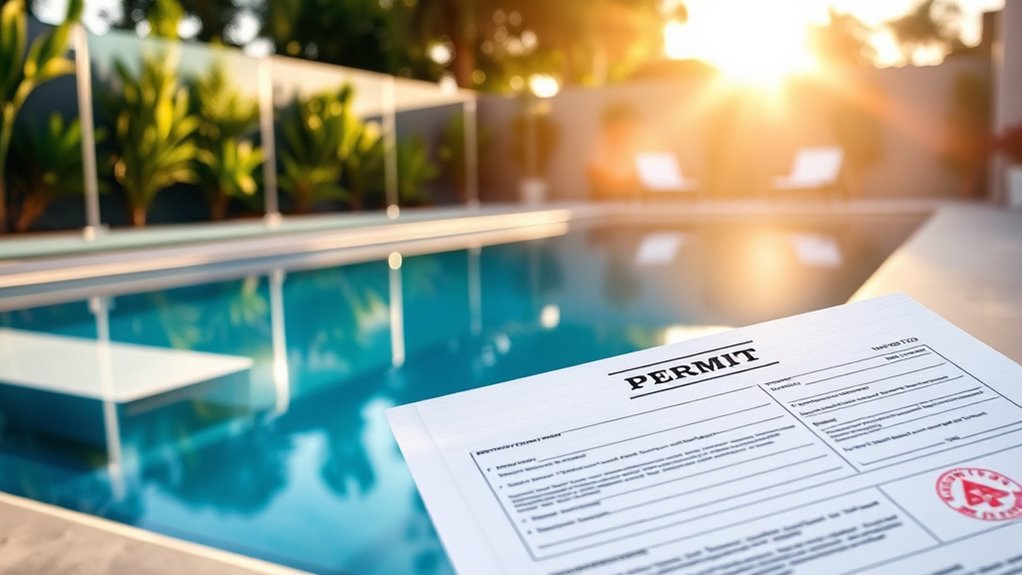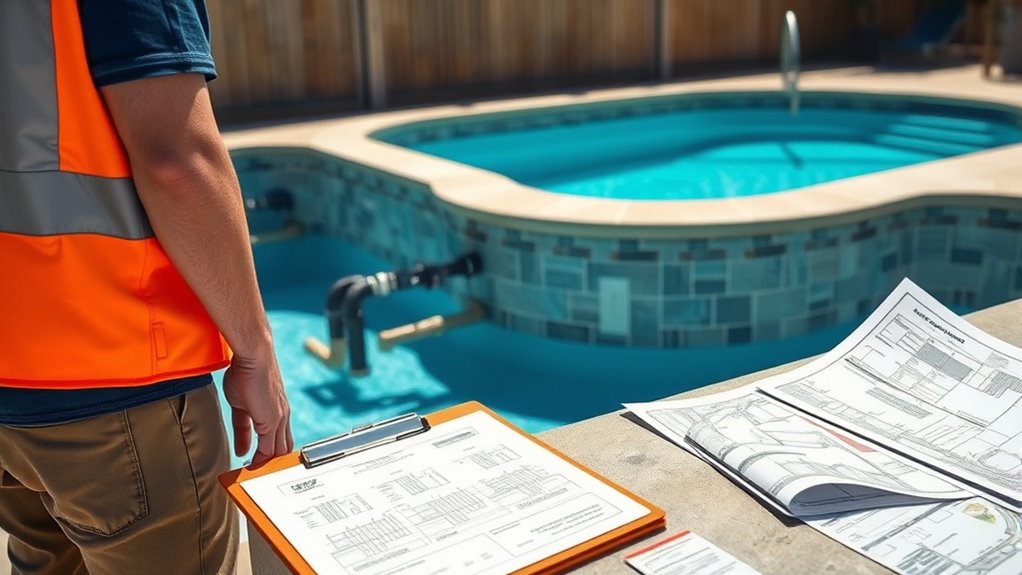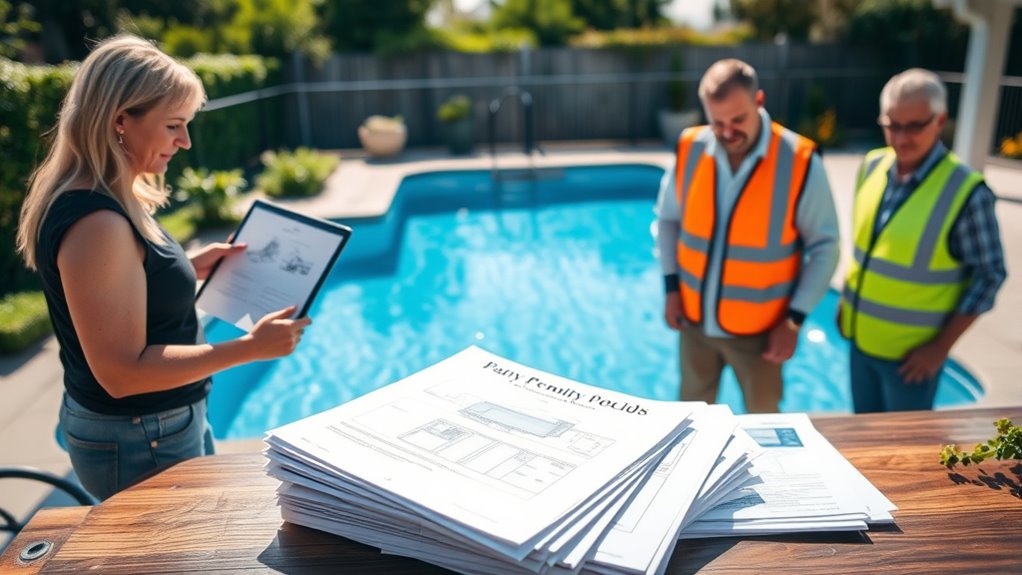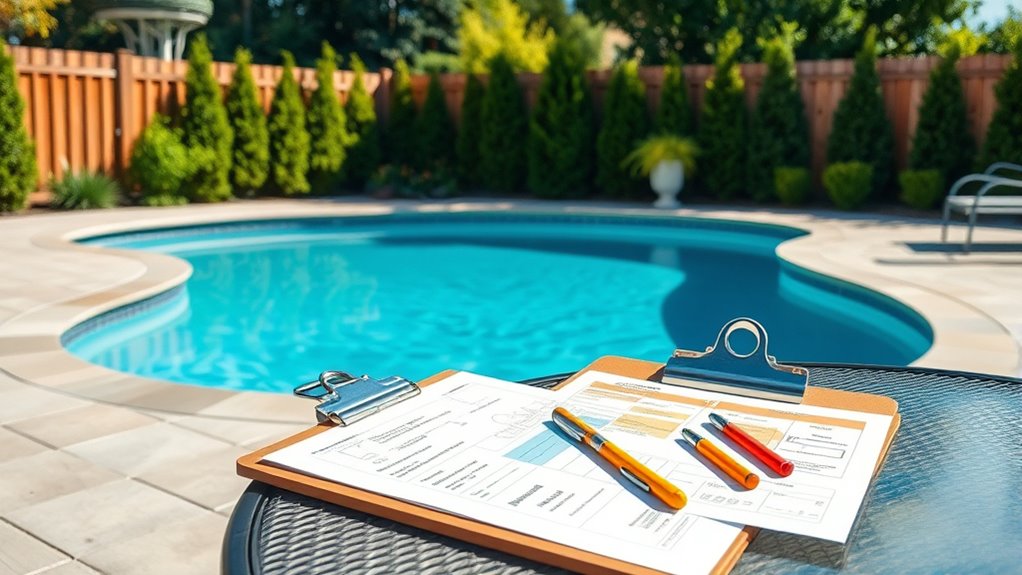If you’re installing a pool, you need to understand local permits and safety rules to stay compliant. Start by contacting your city or county offices to learn about permit requirements, which often include detailed plans, safety barriers, and inspections. Make sure to submit all necessary documents promptly to avoid delays. Knowing these regulations helps prevent fines or future removal. Keep going to discover how to navigate the application process smoothly and efficiently.
Key Takeaways
- Research local city or county requirements early to understand permit needs and avoid delays.
- Ensure compliance with safety regulations like fencing, barriers, and proper electrical wiring.
- Prepare detailed plans, site surveys, and safety documentation for permit applications.
- Expect inspections within 1-2 weeks, with final approval typically granted shortly after passing.
- Address common challenges by submitting complete paperwork early and coordinating with local authorities.
Understanding Local Pool Permit Requirements

Understanding local pool permit requirements is essential before beginning your pool project. You need to research your city or county’s regulations early on to avoid delays or fines. Check with your local building department or planning office to find out what permits are necessary. Some areas require detailed plans, site inspections, or specific safety features. You may also need to submit proof of property surveys or adherence to zoning rules. Failing to obtain the proper permits can lead to costly penalties or even having to remove your pool later. It’s your responsibility to verify all paperwork is correct and approved before starting construction. Taking these steps upfront saves you time, money, and legal headaches in the long run.
Key Regulations for Pool Safety and Design

Once you’ve secured the necessary permits, it’s important to focus on the safety and design regulations that safeguard swimmers and guarantee your pool meets legal standards. These regulations typically include proper fencing to prevent unauthorized access, usually a minimum height of four feet, and self-closing gates with latches. Pool walls and barriers must be resistant to climbing to prevent children from entering unsupervised. You also need to follow specific requirements for drain covers to prevent entrapment and assure proper electrical wiring to avoid shocks. Additionally, safety devices like alarms, pool covers, and safety nets are often mandated for extra protection. Designing your pool with these regulations in mind not only keeps users safe but also helps you avoid legal issues or fines. The contrast ratio of your pool lighting can also influence visibility and safety during nighttime use. Ensuring that your pool complies with all local regulations can significantly reduce the risk of accidents and legal complications.
The Application Process and Necessary Documentation

Are you ready to start the application process for your pool permit? First, gather all required documents, including your property deed, site plans, and proof of compliance with safety regulations. You’ll need to complete the permit application form, which details your pool’s location, size, and safety features. Be prepared to submit detailed drawings or plans showing the pool layout, fencing, and other safety measures. Some municipalities might require additional paperwork, such as environmental impact assessments or proof of contractor licensing. Double-check your local regulations beforehand to guarantee you have everything ready. Familiarize yourself with influence of AI on regulations to understand how technological advancements might affect your permit process. Submitting a complete application with all necessary documentation speeds up approval and prevents delays. Once submitted, you’ll typically receive a confirmation and next steps for inspection and approval.
Inspection Procedures and Approval Timeline

How long does the approval process typically take after you submit your pool permit application? It varies by location, but generally, you can expect a few key steps.
- Initial Review: The permitting office evaluates your plans within 1-2 weeks. Strong communication skills can facilitate quicker responses and clarification during this phase. Being familiar with building codes can help you prepare more accurate plans and avoid delays. Additionally, understanding health and safety standards ensures your plans align with local requirements.
- Inspection Scheduling: Once approved, an inspector visits your site for a safety and code compliance check, usually within 2-5 days. Understanding permitting requirements helps ensure your plans meet all safety standards.
- Final Approval: After passing inspection, you receive the permit, often in 1-3 days. Staying in contact with your local building department and preparing your site properly will help speed up the process. Additionally, understanding inspection procedures can help you anticipate potential issues and streamline your approval timeline.
Common Challenges and Tips for a Smooth Permitting Process

Managing the pool permit process can be challenging, but understanding common obstacles and preparing proactively can make it smoother. One frequent issue is incomplete or incorrect paperwork, which causes delays. Double-check all documents before submission to avoid resubmissions. Another challenge is unfamiliarity with local regulations, so research your city’s specific requirements early. Delays often stem from permit backlogs or inspection scheduling issues, so apply well in advance. Communicate clearly with your permitting office and respond promptly to any requests for additional information. Ultimately, unexpected site issues, like property boundary disputes or hidden underground utilities, can cause setbacks. To prevent these, conduct thorough site assessments beforehand. Conducting a site excavation can reveal potential underground utilities, preventing costly delays later. Being aware of specific Gold IRA regulations can also help ensure your project complies with all legal standards. Staying organized, informed, and proactive ensures your permitting process stays on track, saving you time and frustration. Additionally, understanding the importance of permit compliance can help avoid costly fines or project delays. Properly managing permitting documentation and maintaining clear communication with authorities are also pivotal in streamlining the process. Incorporating Glycolic Acid benefits knowledge can aid in maintaining healthy skin during project-related skin care routines.
Frequently Asked Questions
Are There Specific Age Restrictions for Pool Permits?
When it comes to pool permits, age restrictions usually don’t apply directly. Instead, authorities focus on safety features, fencing, and proper installation. However, if you’re a minor, you might need adult supervision or involvement in the process. It’s best to verify your local regulations, as some areas might have specific guidelines for young homeowners or minors. Always guarantee you follow all safety and permit requirements for a safe swimming experience.
Can Permits Be Transferred if I Sell My Property?
When you sell your property, you might wonder if the pool permit transfers to the new owner. Generally, permits are tied to the property, not the individual, so they often transfer with the sale. However, requirements can vary by location. You should check with your local building department or permit office to confirm whether the permit remains valid or if you need to provide documentation to the new owner.
What Are the Penalties for Building Without a Permit?
If you build without a permit, you risk hefty penalties, including fines and orders to demolish or modify your construction. You could also face delays if you try to sell your property later, as unpermitted work may need inspection or approval before closing. Ignoring permits can lead to legal issues, increased costs, and safety concerns, so always ascertain you get the proper approvals before starting any construction project.
Do Different Pool Types Require Different Permits?
You should know that different pool types often do require different permits. For example, in-ground pools usually need a building permit, while above-ground pools might need only a simple approval or no permit at all, depending on local rules. It’s important to check with your local building department, as regulations vary by location. Failing to obtain the correct permits can lead to fines or having to remove the pool later.
How Can I Expedite the Permitting Process?
You want to speed up the permitting process, so start by gathering all necessary documents, like plans and permits, beforehand. Contact your local permitting office to clarify requirements and ask about fast-track options. Submit complete, accurate applications promptly and follow up regularly. Building good communication with officials and addressing any issues quickly helps avoid delays. Staying organized and proactive will get your pool permit approved faster.
Conclusion
Now that you know the essentials, imagine your backyard transforming—water shimmering, safety measures in place, and approval finally granted. But beware, the process isn’t always straightforward; small overlooked details can delay your dream pool. Staying prepared and informed keeps you one step ahead. Will your next step be a quick approval or a surprise obstacle? Keep these tips in mind, and soon, you’ll be relaxing poolside, enjoying your backyard oasis—just on the other side of the permit.








